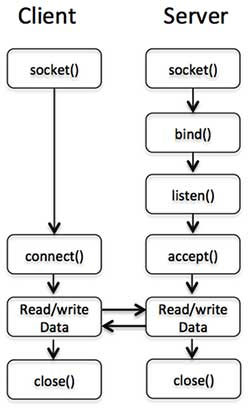Perl Socket programming
Socket is also known as a socket, and applications typically make or respond to network requests through "sockets" that allow communication between hosts or processes on a computer.
In this section, we'll show you how to use the Socket service in the Perl language.
Create a service side
-
Use the socket function to create the socket service.
-
Use the bind function to bind the port.
-
Use the listen function to listen to the port.
-
Use the accept function to receive client requests.
Create a client
-
Use the socket function to create the socket service.
-
Connect to the socket server using the connect function.
The following diagram illustrates the communication flow between the client and the service side:

The service-side socket function
The socket function
In Perl, we use the socket() function to create sockets in the following syntax format:
socket( SOCKET, DOMAIN, TYPE, PROTOCOL );
Parameter resolution:
-
The socket created by domain specifies the protocol set. For example:
-
AF_INETthe IPv4 network protocol -
AF_INET6IPv6 -
AF_UNIXrepresents a local socket (using a file)
-
-
Type socket types can be divided into different types of connections or connections depending on whether SOCK_STREAM or SOCK_DGRAM
-
PROTOCOL should be (getprotobyname ('tcp')). S pecify the transport protocol that is actually in use.
So the socket function is called as follows:
use Socket # 定义了 PF_INET 和 SOCK_STREAM
socket(SOCKET,PF_INET,SOCK_STREAM,(getprotobyname('tcp'))[2]);
Bind() function
Use bind() to assign an address to the socket:
bind( SOCKET, ADDRESS );
SOCKET A socket descriptor. Address is an socket address (TCP/IP) that contains three elements:
-
Address cluster (TCP/IP, is AF_INET, may be 2 on your system)
-
Port number (e.g. 21)
-
Network address (e.g. 10.12.12.168)
When you create a socket using socket(), only the protocol it uses is granted, and no address is assigned. Before accepting a connection from another host, bind() must be called to assign an address to the socket.
A simple example is as follows:
use Socket # 定义了 PF_INET 和 SOCK_STREAM $port = 12345; # 监听的端口 $server_ip_address = "10.12.12.168"; bind( SOCKET, pack_sockaddr_in($port, inet_aton($server_ip_address))) or die "无法绑定端口! \n";
or die is executed after the binding address fails.
By setting setsockopt() you have the option SO_REUSEADDR the settings port can be reused immediately.
pack_sockaddr_in () function converts the address to a binary format.
Listen() function
When the socket is bound to an address, the listen() function starts listening for possible connection requests. However, this can only be used when there is a reliable data flow guarantee:
listen( SOCKET, QUEUESIZE );
SOCKET : A descriptor for a socket.
QUEUESIZE : is an integer that determines the size of the listening queue, which enters when a connection request arrives, moves out of the listening queue when a connection request is accepted by accept(), and returns an error when the queue is full.
Once the connection is accepted, returning 0 indicates success and error returning -1.
Accept() function
The accept() function accepts the requested socket connection. I f successful, return the network address in compressed form, otherwise return FALSE:
accept( NEW_SOCKET, SOCKET );
SOCKET : A descriptor for a socket.
ADDRESS: ADDRESS is an socket address (TCP/IP) that contains three elements:
-
Address cluster (TCP/IP, is AF_INET, may be 2 on your system)
-
Port number (e.g. 21)
-
Network address (e.g. 10.12.12.168)
accept() is usually used in infinite loops:
while(1) {
accept( NEW_SOCKET, SOCKT );
.......
}
The above instances can listen to client requests in real time.
The client function
Connect() function
The connect() system calls to set the connection for a socket with a file descriptor and host address.
connect( SOCKET, ADDRESS );
Here's an instance that connects to the service-side socket:
$port = 21; # ftp 端口
$server_ip_address = "10.12.12.168";
connect( SOCKET, pack_sockaddr_in($port, inet_aton($server_ip_address)))
or die "无法绑定端口! \n";
The full instance
Let's take a full example of how all socket functions are applied:
Service-side server.pl code:
#!/usr/bin/perl -w
# Filename : server.pl
use strict;
use Socket;
# 使用端口 7890 作为默认值
my $port = shift || 7890;
my $proto = getprotobyname('tcp');
my $server = "localhost"; # 设置本地地址
# 创建 socket, 端口可重复使用,创建多个连接
socket(SOCKET, PF_INET, SOCK_STREAM, $proto)
or die "无法打开 socket $!\n";
setsockopt(SOCKET, SOL_SOCKET, SO_REUSEADDR, 1)
or die "无法设置 SO_REUSEADDR $!\n";
# 绑定端口并监听
bind( SOCKET, pack_sockaddr_in($port, inet_aton($server)))
or die "无法绑定端口 $port! \n";
listen(SOCKET, 5) or die "listen: $!";
print "访问启动:$port\n";
# 接收请求
my $client_addr;
while ($client_addr = accept(NEW_SOCKET, SOCKET)) {
# send them a message, close connection
my $name = gethostbyaddr($client_addr, AF_INET );
print NEW_SOCKET "我是来自服务端的信息";
print "Connection recieved from $name\n";
close NEW_SOCKET;
}
Open a terminal and execute the following code:
$ perl sever.pl 访问启动:7890
The client.pl code:
#!/usr/bin/perl -w
# Filename : client.pl
use strict;
use Socket;
# 初始化地址与端口
my $host = shift || 'localhost';
my $port = shift || 7890;
my $server = "localhost"; # 主机地址
# 创建 socket 并连接
socket(SOCKET,PF_INET,SOCK_STREAM,(getprotobyname('tcp'))[2])
or die "无法创建 socket $!\n";
connect( SOCKET, pack_sockaddr_in($port, inet_aton($server)))
or die "无法连接:port $port! \n";
my $line;
while ($line = <SOCKET>) {
print "$line\n";
}
close SOCKET or die "close: $!";
Open another terminal and execute the following code:
$ perl client.pl 我是来自服务端的信息